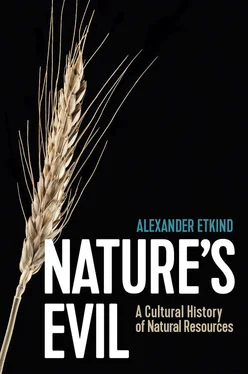In 1794 a young officer from Siberia, Nikolay Rezanov, married Shelikhov’s daughter. Rezanov was one of the most remarkable people in Russian history, but his fourteen-year-old bride didn’t have any inkling of this. She died a few years after the wedding, one of the richest heiresses in the empire. Shelikhov and Rezanov now jointly controlled a great part of the Chinese-Russian trade in fur and tea. 21All this massive volume of trade went via Kyakhta, south of Lake Baikal. An old transit point on the Great Silk Road, this town was the only legal customs post on the Chinese-Russian border, the longest in the world. Trade was done mostly by barter; it was only in 1762 that Catherine allowed private trade in Kyakhta. More than a million chests of tea entered Siberia from China every year, as well as gunpowder, paper and silk. The Russian merchants mostly traded fur, but also hides and horses. The English were a threat to this trade: they had already taken American furs to Canton (Guangzhou).
Catherine died, and after much manoeuvring the young emperor Paul I signed a statute for the creation of the Russian-American Company. The documents were drafted by Gavriil Derzhavin, the president of the Collegium of Commerce, who is better remembered as a powerful poet. Rezanov was a student of Derzhavin’s and had served in his office. The collaboration between Derzhavin, Shelikhov and Rezanov resulted in the most ambitious global project ever known to the Russian Empire. The Russian-American Company obtained a monopoly on a huge territory to the east of Siberia and to the north of Japan, including Alaska. Rezanov’s plan encompassed the colonisation of these lands, their settlement by peasants and Cossacks, the building of ports, wharves and towns, the extraction of minerals and furs, and trade across two oceans. He intended the Russian-American Company to expand south as far as California and Sakhalin and planned a naval base at the estuary of the Amur. If his plans had been accomplished, the Pacific Ocean would have become a lake within the Russian Empire. In the meantime, Russian roads, bad as they were, ran out at Irkutsk, in the centre of Siberia. The winter route from there to the Pacific coast took seven months, and all the time in the world would not suffice to make the route possible in summer. To provision its colony in Alaska, the empire sent ships from Odessa round Africa: this journey across three oceans turned out to be quicker, cheaper and safer than the overland route through Russian territory. In 1805 a pud (16 kilograms) of flour cost 50 kopecks in Irkutsk, 10 roubles in Okhotsk, 40 roubles in Kamchatka, and even more in Alaska.
The establishment of the Russian-American Company closed a large circle in which the plans of world empires were codified according to the spirit of corporate capitalism. The Muscovy Company, which had been established by Sebastian Cabot and John Dee in 1533, was one of the first joint stock companies founded for long-distance trade (hemp and timber); then came the English East India Company (tea and opium), the Dutch East India Company (tea and spices), the Hudson Bay Company (fur), and a number of Prussian, Danish and even Latvian projects. The Russian-American Company was another institution of resource-oriented expansion based on a state–private partnership. Triangular trade in the Atlantic was bringing unheard-of wealth to the merchants and state treasuries. The Russian-American Company would create an equally massive trade in the Pacific. American-manufactured goods would be traded for Alaskan fur, fur bartered for Chinese tea, and the tea sold in the Russian Empire and the Americas.
With credit from the tsar, the Russian-American Company bought two old English frigates and hired a British crew. Rezanov was appointed the expedition’s commander and the tsar’s representative in Russian America. The captain was Ivan Krusenstern, and the rivalry between these two powerful personalities started immediately. 22When the ships reached Russian America, the expedition’s doctor, Georg Langsdorf, was horrified: ‘The Russians kill everything that moves, for the sake of an instant profit. They don’t realize that they are permanently depriving themselves of a potential source of wealth.’ Steller’s sea cow, a helpless source of meat, became extinct. Seals had no fear of people, who beat them to death with sticks. More than a million seals were killed by the company, and their rotting carcasses and skeletons littered the shoreline. The more wary, but much more valuable sea otters were killed in their thousands. In essence, this colony was a trading post which bartered fur with the Aleutians, who were able to hunt sea otters using their traditional kayaks and javelins. To motivate the Aleutians, the company banned them from their traditional fishing. They were made to buy dried fish from the company; this put them in debt, which they had to work to pay off. Russian ships very rarely took supplies on board, and only trade with American ships saved the crew from starvation. During the whole century that this Russian colony in America existed, the authorities never set up a court or built a prison. The administration used corporal punishment or exiled uncooperative natives to remote islands. Epidemics of unknown illnesses broke out among the Aleutians. Their population dwindled almost as fast as that of the sea otters: in 1805 there were ten times fewer Aleutians on Kodiak than in 1791. But monks opened a church school for the natives.
The colonists developed scurvy. The monks tried to grow watermelons and tobacco but were successful only with potatoes, radishes and barley. Living with their Aleutian wives and creole children, the colonists had no desire to return to Russia. There was no Russian currency in the colony; it was either completely banned or ersatz banknotes were printed on seal skin. There was no ownership of land; as the colony depended entirely on trading fur in exchange for provisions, land had no value. The real unit of exchange was barrels of American rum. From the naval officers to the downtrodden Aleutians, practically everyone was constantly drunk.
In 1802 skirmishes broke out between the Russian colonists and the Tlingit warrior tribe. The Tlingits traded fur with the Americans and possessed firearms: a sea otter pelt went for a musket. After two years of war the Tlingits retreated to the mountains, and the Russians captured their citadel, Sitka. 23This now became the capital of Russian America, Novo-Arkhangelsk. The bay provided a convenient anchorage for American sailors, and they willingly exchanged provisions for fur; moreover, they could hire Aleutians and their kayaks to hunt sea otters in California. An American sea captain, John DeWolf, sold Rezanov an eight-cannon ship with a cargo of tobacco and rum; Rezanov paid with a promissory note from the Russian-American Company and 572 sea otter pelts. The bargain was kept – having sent the pelts to Canton, DeWolf crossed Siberia overland, received his money in St Petersburg, and returned to Connecticut. This Russian-speaking Yankee had an interesting nephew, the writer Herman Melville, who learnt about whales, travel and determination from him. In an official letter to the Russian-American Company, Rezanov warned that the fur trade would lead to extinction and suggested a diversification plan. From his base in Alaska, he planned to export timber, develop Sakhalin Island and oust the Spanish from California. He planned to sow wheat, which would finally solve the problem of provisioning Russian America. Following the English model, he proposed to export criminals from central Russia to Alaska and, in addition, to buy up male serfs. The women would be brought from the Aleutian population.
In 1803 President Jefferson bought Louisiana from the French at the price of 3 cents per acre; this almost doubled the territory of the United States, and Napoleon got the money for his European war. Rezanov knew that the world would be made anew, and he intended to be a part of it. In 1806 he set off for the Spanish colony of California. In San Francisco he fell in love with the daughter of the Spanish governor, and fifteen-year-old Conchita accepted his proposal. After the betrothal, his ship took on grain and the happy Rezanov started planning new projects. Russian-Spanish America would stretch from Alaska to California. Prairie farming, the timber trade and new industries would compensate for the depletion of fur. But to marry Conchita he needed to receive the blessing of the emperor and the permission of the pope.
Читать дальше












